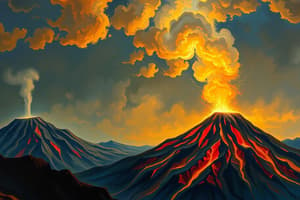Podcast
Questions and Answers
What are volcanoes?
What are volcanoes?
They are vents in the earth's surface where gases, lava and pyroclastic material are erupted.
How are volcanoes classified?
How are volcanoes classified?
They are classified based on their height, shape, magma type, and eruption style.
What are the two primary types of volcanoes?
What are the two primary types of volcanoes?
Shield and composite volcanoes.
What are considered to be secondary volcanoes and why?
What are considered to be secondary volcanoes and why?
What are cinder cone volcanoes?
What are cinder cone volcanoes?
What are composite volcanoes?
What are composite volcanoes?
What are lava domes?
What are lava domes?
What are shield volcanoes?
What are shield volcanoes?
Flashcards are hidden until you start studying
Study Notes
Volcanoes Overview
- Volcanoes are vents on the Earth's surface that erupt gases, lava, and pyroclastic materials.
Classification of Volcanoes
- Volcanoes can be classified by height, shape, magma type, and eruption style.
Primary Volcano Types
- Two main types of volcanoes: shield and composite volcanoes.
Secondary Volcanoes
- Cinder cone and lava domes are considered secondary volcanoes as they typically occur near primary volcanoes.
Cinder Cone Volcanoes
- Formed from pyroclastic materials ejected and falling back around the vent, creating a cone-shaped pile.
- Characterized by being small, steep-sided, and symmetrical.
- Can emerge in the crater or on the flanks of larger volcanoes.
Composite Volcanoes
- Also known as stratovolcanoes, formed from alternating layers of rock, ash, and hardened lava.
- Known for explosive eruptions due to high-viscosity, high-silica magma with low melting temperatures.
- Typically steeper near the summit and usually located at subduction zones.
Lava Domes
- Created when magma beneath the surface exerts significant upward pressure, resulting in viscous magma rising to form steep-sided, bulging mounds.
- Grow slowly but can produce highly explosive eruptions.
Shield Volcanoes
- Large and broad with low magma viscosity, giving them gradual slopes and significant base widths.
- Erupt gently, producing extensive volumes of magnesium-rich magma but are not steep.
Studying That Suits You
Use AI to generate personalized quizzes and flashcards to suit your learning preferences.




